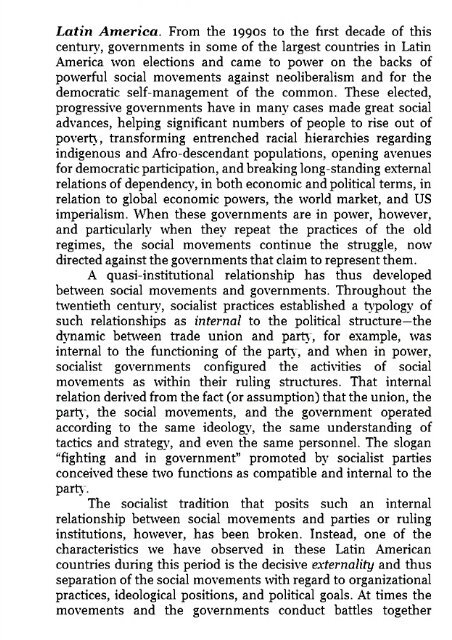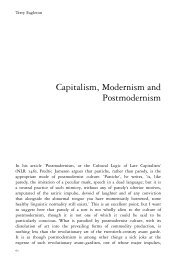Chapter 1: Subjective Figures of the Crisis ... - Negri in English
Chapter 1: Subjective Figures of the Crisis ... - Negri in English
Chapter 1: Subjective Figures of the Crisis ... - Negri in English
You also want an ePaper? Increase the reach of your titles
YUMPU automatically turns print PDFs into web optimized ePapers that Google loves.
Lat<strong>in</strong> America. From <strong>the</strong> 1990s to <strong>the</strong> first decade <strong>of</strong> this<br />
century, governments <strong>in</strong> some <strong>of</strong> <strong>the</strong> largest countries <strong>in</strong> Lat<strong>in</strong><br />
America won elections and came to power on <strong>the</strong> backs <strong>of</strong><br />
powerful social movements aga<strong>in</strong>st neoliberalism and for <strong>the</strong><br />
democratic self-management <strong>of</strong> <strong>the</strong> common. These elected,<br />
progressive governments have <strong>in</strong> many cases made great social<br />
advances, help<strong>in</strong>g significant numbers <strong>of</strong> people to rise out <strong>of</strong><br />
poverty', transform<strong>in</strong>g entrenched racial hierarchies regard<strong>in</strong>g<br />
<strong>in</strong>digenous and Afro-descendant populations, open<strong>in</strong>g avenues<br />
for democratic participation, and break<strong>in</strong>g long-stand<strong>in</strong>g external<br />
relations <strong>of</strong> dependency, <strong>in</strong> both economic and political terms, <strong>in</strong><br />
relation to global economic powers, <strong>the</strong> world market, and US<br />
imperialism. When <strong>the</strong>se governments are <strong>in</strong> power, however,<br />
and particularly when <strong>the</strong>y repeat <strong>the</strong> practices <strong>of</strong> <strong>the</strong> old<br />
regimes, <strong>the</strong> social movements cont<strong>in</strong>ue <strong>the</strong> struggle, now<br />
directed aga<strong>in</strong>st <strong>the</strong> governments that claim to represent <strong>the</strong>m.<br />
A quasi-<strong>in</strong>stitutional relationship has thus developed<br />
between social movements and governments. Throughout <strong>the</strong><br />
twentieth century, socialist practices established a typology <strong>of</strong><br />
such relationships as <strong>in</strong>ternal to <strong>the</strong> political structure—<strong>the</strong><br />
dynamic between trade union and part}', for example, was<br />
<strong>in</strong>ternal to <strong>the</strong> function<strong>in</strong>g <strong>of</strong> <strong>the</strong> part}', and when <strong>in</strong> power,<br />
socialist governments configured <strong>the</strong> activities <strong>of</strong> social<br />
movements as with<strong>in</strong> <strong>the</strong>ir rul<strong>in</strong>g structures. That <strong>in</strong>ternal<br />
relation derived from <strong>the</strong> fact (or assumption) that <strong>the</strong> union, <strong>the</strong><br />
part}', <strong>the</strong> social movements, and <strong>the</strong> government operated<br />
accord<strong>in</strong>g to <strong>the</strong> same ideology, <strong>the</strong> same understand<strong>in</strong>g <strong>of</strong><br />
tactics and strategy, and even <strong>the</strong> same personnel. The slogan<br />
"fight<strong>in</strong>g and <strong>in</strong> government" promoted by socialist parties<br />
conceived <strong>the</strong>se two functions as compatible and <strong>in</strong>ternal to <strong>the</strong><br />
part}'.<br />
The socialist tradition that posits such an <strong>in</strong>ternal<br />
relationship between social movements and parties or rul<strong>in</strong>g<br />
<strong>in</strong>stitutions, however, has been broken. Instead, one <strong>of</strong> <strong>the</strong><br />
characteristics we have observed <strong>in</strong> <strong>the</strong>se Lat<strong>in</strong> American<br />
countries dur<strong>in</strong>g this period is <strong>the</strong> decisive externality and thus<br />
separation <strong>of</strong> <strong>the</strong> social movements with regard to organizational<br />
practices, ideological positions, and political goals. At times <strong>the</strong><br />
movements and <strong>the</strong> governments conduct battles toge<strong>the</strong>r










